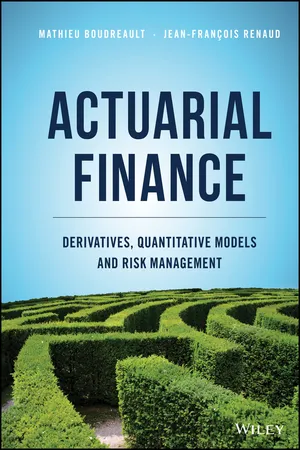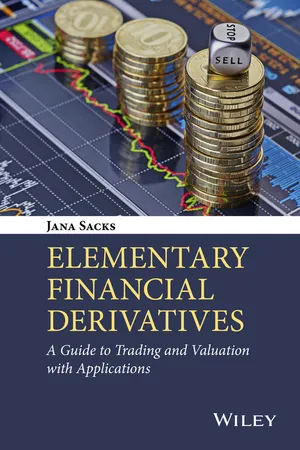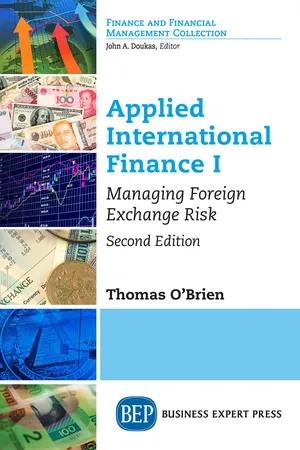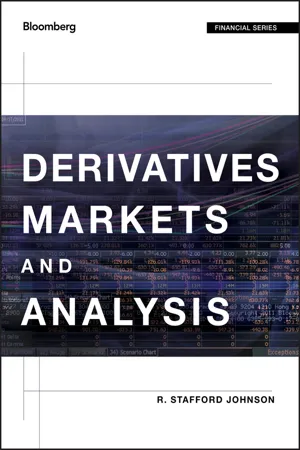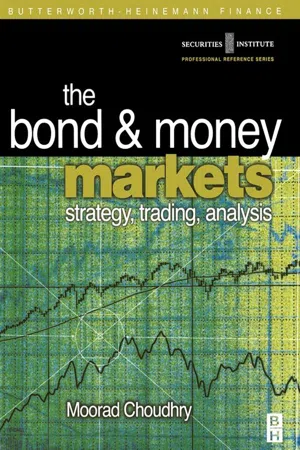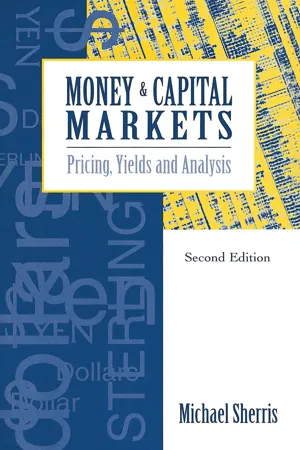Economics
Swaps
Swaps are financial agreements between two parties to exchange cash flows or other financial instruments. They are commonly used to manage risk, hedge against fluctuations in interest rates or currency values, and to customize investment strategies. Swaps can involve various underlying assets, such as interest rates, currencies, commodities, or securities.
Written by Perlego with AI-assistance
Related key terms
Related key terms
1 of 4
Related key terms
1 of 3
9 Key excerpts on "Swaps"
- eBook - ePub
Actuarial Finance
Derivatives, Quantitative Models and Risk Management
- Mathieu Boudreault, Jean-François Renaud(Authors)
- 2019(Publication Date)
- Wiley(Publisher)
4 SwapsA swap is an agreement between two parties to exchange cash flows at predetermined dates with contractual terms set at inception. A swap usually involves exchanging periodically variable (random) payments, whose value is based on a financial benchmark or an underlying asset (a stock, a bond, an index or some economic or financial quantity), for fixed payments. No premium is exchanged at inception. Figure 4.1 illustrates cash flows of a swap, where the words variable, floating and risky are used interchangeably.Figure 4.1Periodic cash flows of a general swapBased upon this definition of a swap, common insurance policies can also be viewed as Swaps for ordinary people. For example, a 2-year car insurance policy is similar to a swap since the policyholder makes a fixed monthly payment in exchange for variable/random amounts, i.e. the compensation for losses due to car accidents, theft or vandalism. In Figure 4.1 , the policyholder is the investor in the left box whereas the insurance company is the investor in the right box.Just like other financial derivatives, Swaps are mostly used for risk management, i.e. to offset a risk exposure, or for speculation, i.e. to bet on/against the underlying asset. Risks that investors may want to swap are interest rate risk, currency risk, credit risk, etc. Examples of applications include:- When interest rates go down, the present value of actuarial liabilities can increase significantly. Insurance companies and pension plan sponsors can use interest rate Swaps to mitigate the impact of a decrease in interest rates.
- Your company uses gold to make jewelry and needs to regularly buy ounces of gold. To help fix those periodic cash outflows, your company can enter into a gold swap to fix the price it will pay for regular deliveries of gold over the next few months.
- A company based in the U.S. receives a regular stream of Euros from its subsidiaries. Those cash flows need to be converted into U.S. dollars, but this is of course subject to fluctuations of the USD/EUR exchange rate. The company may enter into a currency swap
- eBook - ePub
Elementary Financial Derivatives
A Guide to Trading and Valuation with Applications
- Jana Sacks(Author)
- 2015(Publication Date)
- Wiley(Publisher)
3 Swaps3.1 Swaps Fundamentals
Swaps were first introduced to the public in 1981 when IBM and the World Bank entered into a swap. Today, Swaps are the most heavily traded financial contracts in the world. The swap markets are enormous in size on the world scale. According to the Bank for International Settlements (BIS), the total amount of interest rates and currency Swaps outstanding was around $348 trillion in 2010. The whole derivatives market was over $600 trillion in 2013.In that it may be surprising that Swaps as of now are still nonstandardized contracts and therefore are traded over the counter (OTC). Given the high frequency of contract structuring, in order to facilitate trading, market participants have developed the ISDA Master Agreement, which covers the legal terms of a swap contract, such as representations and warranties, and events of termination and default. Swaps are subject to credit risk. Other than that counterparties in a swap only need to negotiate the notional principal, interest rate or price, expiration, and collateral, if necessary. Interestingly, swap transactions are usually not disclosed on corporate balance sheets. Most recently proposed legislation changes may alter that.Swaps are contract agreements in which one party agrees to make a series of regularly scheduled payments to another party and receive payments from the other party. In a swap, parties exchange assets, liabilities, currencies, securities, and commodities. There is a spectrum of complexity that swap structures may exhibit. An example of a rather simple one is a floating-for-fixed-rate swap. The most complex ones include multiple currencies, interest rates, commodities, and options. As is the case with OTC derivatives, Swaps are flexible in terms of specifications such as timing or contractual horizons, settlement procedures, and so on.Generally, Swaps are used for risk management by relatively large institutions such as banks, brokers, dealers, and corporations. Individuals are not excluded but have to be qualified in order to be permitted to participate in swap transactions. At the outset of a swap, the swap has value of zero. No cash changes hands between counterparties. The reason for the zero value is that the future anticipated flows of each of the two counterparties' cash flows exactly equal one another in their present value. Swap payments are settled on regularly scheduled settlement dates. Exchanging the difference between swap payments only is called netting the payment. The final payment coincides with the termination date of the swap contract (Fig. 3.1 - eBook - ePub
- Thomas J. O'Brien(Author)
- 2017(Publication Date)
- Business Expert Press(Publisher)
CHAPTER 6Currency Swaps“The advent of Swaps, as much as anything else, helped transform the world’s segmented capital markets into a single, truly integrated, international capital market.”—John F. Marshall and Kenneth R. Kapner (1993)A currency swap is a contract to exchange two streams of future cash flows in different currencies. Currency Swaps were initially designed to circumvent capital controls imposed by governments and to make borrowing more efficient in global markets. We will see that currency Swaps are used to convert debt denominated in one currency into “synthetic” debt denominated in another currency. Synthetic debt created in this way sometimes allows a segment of the capital market to be tapped that would otherwise not be accessible with actual debt denominated in that currency. By themselves, moreover, currency Swaps are useful in managing FX business exposure in situations where foreign currency net debt is not practical.World Bank—IBM SwapThe first currency swap seems to be a 1981 transaction between the World Bank and IBM. Its details are instructive. The World Bank wanted to raise additional capital by issuing new debt and to denominate the debt payments in Swiss francs because of a low market interest rate in that currency. The U.S. bond market, though, was more receptive to World Bank bonds than was the Swiss bond market, because the World Bank had already saturated the Swiss market’s “appetite” for its bonds, and U.S. investors regarded World Bank bonds to have much less credit risk than Swiss investors did. However, the U.S. investors wanted bonds denominated in US dollars.At the same time, IBM had previously financed by issuing some Swiss franc debt, but had since developed the view that the Swiss franc was undervalued, and thus was likely to appreciate abnormally relative to the US dollar. IBM thus wanted to replace its Swiss franc debt with US dollar debt. But issuing new US dollar bonds and using the proceeds to repurchase the Swiss franc bonds would be relatively expensive in terms of transaction costs. - eBook - ePub
- R. Stafford Johnson(Author)
- 2017(Publication Date)
- Bloomberg Press(Publisher)
PART 4 Financial SwapsPassage contains an image
CHAPTER 14 Interest Rate Swaps
A swap, by definition, is a legal arrangement between two parties to exchange specific payments. There are three types of financial Swaps:- Interest rate Swaps: The exchange of fixed‐rate payments for floating‐rate payments
- Credit default Swaps: the exchange of premium payments for default protection
- Currency Swaps: The exchange of liabilities in different currencies
In this chapter, we examine the markets, uses, and pricing of standard interest rate Swaps and two interest rate swap derivatives—forward Swaps and swaptions. In Chapter 15 , we examine the markets, uses, and pricing of credit default Swaps and currency Swaps.Generic Interest Rate Swaps
The simplest type of interest rate swap is the plain vanilla swap or generic swap. In this agreement, one party provides fixed‐rate interest payments to another party who provides floating‐rate payments. The parties to the agreement are counterparties. The party who pays fixed interest and receives floating is the fixed‐rate payer; the other party (who pays floating and receives fixed) is the floating‐rate payer.On a generic swap, principal payments are not exchanged. As a result, the interest payments are based on a notional principal (NP).The interest rate paid by the fixed payer often is specified in terms of the yield to maturity (YTM) on a T‐note plus basis points; the rate paid by the floating payer on a generic swap is the LIBOR. Swap payments on a generic swap are semiannual and the maturities typically range from 3 to 10 years. In the swap contract, a trade date, effective date, settlement date, and maturity date are specified. The trade date is the date the parties agree to commit to the swap; the effective date is the date when interest begins to accrue; the settlement or payment date is when interest payments are made (interest is paid in arrears six months after the effective date); and the maturity date is the last payment date. On the payment date, only the interest differential between the counterparties is paid. That is, generic swap payments are based on a net settlement basis: The counterparty owing the greater amount pays the difference between what is owed and what is received. Thus, if a fixed‐rate payer owes $3 million and a floating‐rate payer owes $2.5 million, then only a $0.5 million payment by the fixed payer to the floating payer is made. All of the terms of the swap are specified in a legal agreement signed by both parties called the confirmation. The drafting of the confirmation often follows document forms suggested by the International Swap and Derivative Association - Moorad Choudhry(Author)
- 2001(Publication Date)
- Butterworth-Heinemann(Publisher)
39Swaps I
39.1 Introduction
The growth in the Swaps market illustrates perfectly the flexibility and application of financial engineering in the capital markets. The market is large and liquid and has a variety of applications; the notional principal outstanding of interest-rate Swaps exceeded $6,000 billion at the end of 1998. The annual turnover in Swaps and forward-rate agreements (FRAs) combined has been estimated at $37 trillion notional.1 Swaps are synthetic securities involving combinations of two or more basic building blocks. Most Swaps currently traded in the market involve combinations of cash market securities, for example a fixed interest rate security combined with a floating interest rate security, possibly also combined with a currency transaction. However the market has also seen Swaps that involve a futures or forward component, as well as Swaps that involve an option component. The first example of a swap is thought to be that set up between IBM and the World Bank in 1981, since when the swap market has grown considerably. The market in say, dollar, euro and sterling interest rate Swaps is very large and very liquid. The main types of swap are interest rate Swaps, asset Swaps, basis Swaps, fixed-rate currency Swaps and currency coupon Swaps. The market for Swaps is organised by the International Swap Dealers Association (ISDA).The origin of the swap market was the market in parallel and “back-to-back” loans that existed during the 1970s, when restrictions on the exchange of foreign currency limited the ability of companies and investors to finance overseas activities. So-called parallel loans could only be arranged where there were two companies, with subsidiaries in each other's countries, each of whom required the same level of funding; as such they were very inflexible. We do not need to concern ourselves with the structure of such loans. The elimination of foreign exchange controls at the end of the 1970s in the US and UK, soon followed in other countries, allowed straight cross-border loans to take place. The first Swaps were cross-currency Swaps , which as we shall later remove the exchange risk associated with a loan made in two different currencies. These Swaps were bilateral agreements between two companies directly, which required both counterparties to have essentially exactly opposite borrowing requirements. Gradually banks ceased acting as brokers between two companies with opposite requirements, charging a fee for the service, and instead became direct counterparties to companies who required both cross-currency and interest-rate Swaps. If the other side to a swap could be found by the bank in the market, then the first swap could be hedged. However often there would not be another counterparty with the exact opposite requirements, so the bank would manage the swap on its own book, which would be hedged with another swap or other financial instruments. Banks thus became principals and market makers in Swaps, and the activity of maintaining Swaps on a bank's own book was known as warehousing- eBook - ePub
Money and Capital Markets
Pricing, yields and analysis
- Michael Sherris(Author)
- 2023(Publication Date)
- Routledge(Publisher)
7 SwapsSwaps are used extensively in money and capital markets. These transactions have in common the exchange between 2 counterparties of cash flows of one sort or another. The main types of transactions are bill Swaps, interest rate Swaps, the foreign currency swap (or deposit swap) and foreign exchange or cross currency Swaps. Bond switches are also referred to as bond Swaps. Futures and forward contracts are similar to Swaps in that they effectively involve an exchange of a variable amount for a fixed amount on a future date.Bill Swaps
The bank bill swap transaction is used to create a synthetic security which has a term to maturity not normally available in the physical short-term market. The synthetic security is created by the purchase of a physical security and the simultaneous purchase of a ‘strip’ of futures contracts. This synthetic security is then sold. The bill swap is the ‘securitised’ form of a ‘reverse cash and carry’ transaction in futures markets. It is called a swap because the transaction involves the swap of the synthetic security for a physical bank bill.The rollover yield on a bank bill can be fixed using BAB interest rate futures contracts. The rollover yield is the purchase yield for a physical security on maturity of the security. A synthetic security with a longer maturity than is available in the physical bank bill market can be created by purchasing a strip of BAB futures contracts. A bill swap requires a number of bank bill transactions at future dates, since a physical bank bill is used to back the synthetic security.In a bill swap a bank bill is sold at a price determined as the present value of the face value of the swap. For the purchaser of a bill swap the transaction is in effect the same as purchasing a long-term discount security. The proceeds of the bill swap are used by the seller of the swap to purchase a physical bank bill for the same face value as the swap. At each rollover of the physical bank bill a new bill is ‘swapped’ for the maturing bill. No payment is made between the buyer and seller of the bill swap on these rollover dates. On maturity of the bill swap the face value is paid to the buyer of the swap. This maturity payment will equal the face value on maturity of the final physical bank bill. The rollover dates for the physical bank bills coincide with the BAB futures contract settlement dates. - eBook - ePub
- (Author)
- 2023(Publication Date)
- Wiley(Publisher)
1. IntroductionSwap contracts were introduced earlier as a firm commitment to exchange a series of cash flows in the future, with interest rate Swaps where fixed cash flows are exchanged for floating payments being the most common type. Subsequent lessons addressed the pricing and valuation of forward and futures contracts across the term structure, which form the building blocks for swap contracts.In this lesson, we will explore how swap contracts are related to these other forward commitment types. While financial intermediaries often use forward rate agreements or short-term interest rate futures contracts to manage interest rate exposure, issuers and investors usually prefer swap contracts, since they better match rate-sensitive assets and liabilities with periodic cash flows, such as fixed-coupon bonds, variable-rate loans, or known future commitments. It is important for these market participants not only to be able to match expected future cash flows using Swaps but also to ensure that their change in value is consistent with existing or desired underlying exposures. The following lessons compare swap contracts with forward contracts and contrast the value and price of Swaps. - eBook - ePub
The New Lombard Street
How the Fed Became the Dealer of Last Resort
- Perry Mehrling(Author)
- 2010(Publication Date)
- Princeton University Press(Publisher)
From the start, the Bretton Woods system was built on a contradiction. It established a fixed exchange rate system internationally even as it endorsed uncoordinated macroeconomic management at the level of the individual nation-state. The solution to this contradiction was supposed to be capital controls. Some countries might have loose macroeconomic policy while others might have tight macroeconomic policy. In order that the loose ones not be constrained by loss of international reserves, individual countries were permitted to control international capital flows, in and out.The birth of the swap came as a way for individual firms to get around these national controls. The first such Swaps were arranged as parallel loans, and this parallel loan construction remains the most straightforward way to understand them, even though in later developments the loans became implicit rather than explicit.1 Indeed, the parallel loan interpretation is the most straightforward way to understand interest rate Swaps and credit default Swaps as well, two later constructions that played a key role in extending the logic of arbitrage throughout the evolving postwar financial system. The swap idea was completely central, and it all started with the currency swap, so it is of some importance to understand how this swap worked.Currency Swaps and the UIP NormThe essence of banking is a swap of IOUs. When a bank makes a loan, it adds to its balance sheet both an asset (the loan) and a liability (a deposit in the name of the borrower). The first currency Swaps were nothing more than a minor variation on this traditional banking idea. Suppose an American company A has dollars but needs pounds in order to finance expansion by its subsidiary in England, and a British company B has pounds but needs dollars in order to finance expansion by its subsidiary in the United States. Suppose further that capital controls prevent them from trading currencies and making the desired investment directly. They can accomplish essentially the same thing by using a parallel loan construction. - eBook - ePub
- R. Stafford Johnson(Author)
- 2010(Publication Date)
- Wiley(Publisher)
Journal of Derivatives 4, no. 4 (Summer 1997): 67-79.Sun, T., S. Sundaresan, and C. Wang. “Interest Rate Swaps: An Empirical Investigation.” Journal of Financial Economics 36 (1993): 77-99.Titman, S. “Interest Rate Swaps and Corporate Financing Choices.” Journal of Finance, 47, no. 4 (1992): 1503-16.Turnbull, S. M. “Swaps: A Zero Sum Game.” Financial Management 16, no. 1 (Spring 1987): 15-21.Wall, L. D., and J. J. Pringle. “Alternative Explanations of Interest Rate Swaps: A Theoretical and Empirical Analysis.” Financial Management 18, no. 2 (Summer 1989): 59-73.Passage contains an image
CHAPTER 21Swap Derivatives: Forward Swaps and Swaptions21.1 INTRODUCTION
Today, there are a number of nonstandard or nongeneric Swaps used by financial and nonfinancial corporations to manage their varied cash flow and return-risk positions. Two of the most widely used nongeneric Swaps are the forward swap and options on Swaps or swaptions. A forward swap is an agreement to enter into a swap that starts at a future date at an interest rate agreed upon today. A swaption, in turn, is a right, but not an obligation, to take a position on a swap at a specific swap rate. In this chapter, we examine these two interest rate swap derivatives.21.2 FORWARD Swaps
Like futures contracts on debt securities, forward Swaps provide borrowers and investors with a tool for locking in a future interest rate. As such, they can be used to manage interest rate risk for fixed-income positions.Hedging a Future Loan with a Forward Swap
Financial and nonfinancial institutions that have future borrowing obligations can lock in a future rate by obtaining forward contracts on fixed-payer swap positions. For example, a company wishing to lock in a rate on a five-year, fixed-rate $100 million loan to start two years from today could enter a two-year forward swap agreement to pay the fixed rate on a five-year 9%/LIBOR swap. At the expiration date on the forward swap, the company could issue floating-rate debt at LIBOR that, when combined with the fixed position on the swap, would provide the company with a synthetic fixed-rate loan paying 9%:Instrument Action Issue floating-rate note Pay LIBOR −LIBOR Swap: Fixed-rate payer’s position Pay fixed rate −9% Swap: Fixed-rate payer’s position Receive LIBOR + LIBOR Synthetic fixed rate Net payment 9%
Index pages curate the most relevant extracts from our library of academic textbooks. They’ve been created using an in-house natural language model (NLM), each adding context and meaning to key research topics.
Explore more topic indexes
Explore more topic indexes
1 of 6
Explore more topic indexes
1 of 4
